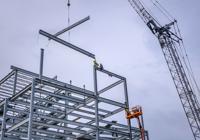GREENVILLE – It’s all about interest rates.
Defying national trends and despite the deep economic disruptions caused by the coronavirus last spring, the Greenville area is thriving with property sales bursting beyond perpandemic levels.
Atlanta real estate analyst John Hunt visited Greenville on Thursday to provide a better estimate of what the 2021 market will look like. Speaking to members of the Greenville Home Builders Association meeting for an annual forecast meeting at the Convention Center of Greenville, Hunt said home construction increased 20 percent in the state’s countryside in 2020 and is expected to increase another 20 percent in 2021.
Upstate includes Anderson, Spartanburg, Greenville, Laurens, Pickens and Oconee counties.
At worst, the pandemic pushed unemployment levels to 15% nationwide, said Hunt, but that still left plenty of demand for housing among the remaining 85%. Greater Greenville, a region that includes the counties of Greenville, Laurens, Anderson and Pickens, in turn, has a relatively healthy job market, with unemployment at 3.6% in November, according to the US Bureau of Labor Statistics . Unemployment stood at 2.1 percent in November 2019.

Two interdependent factors are driving the bustling market, said Hunt: mortgage interest rates below 4 percent and a maturing Millennial generation – a bigger market now than Baby Boomers – eager to settle and get rid of rental rates overwhelming.
Apartments in downtown Greenville measuring between 490 and 600 square feet – that is, not much larger than a two-car garage – are being rented for $ 1,300 to $ 1,500, Hunt noted.
A $ 300,000 30-year loan with interest of 3% or less, the current rate, promises monthly payments of less than $ 1,300.
“Millennials are not stupid,” said Hunt. “It is cheaper to buy than to rent.”
Under current conditions, he predicted, only an increase in interest rates will prevent the buying trend in the interior of the state.
“I think the market has shown us that the buyer has a limit above 4 (percent), beyond which they will stop buying,” said Hunt. “So, I would look at interest rates. I think they will stay low for a long time.”

Greenville County led house building in the state during 2020 and grew 33% compared to 2019.
According to reports from the Associated Press, the Federal Reserve bank is likely to keep interest rates low for at least another year.
South Carolina Governor Henry McMaster made a brief appearance at the home builders’ meeting and was enthusiastic about the state’s economic prospects.

South Carolina Governor Henry McMaster speaks at the Home Builders Association of Greenville’s annual housing forecast meeting at the Greenville Convention Center on Thursday, January 21, 2021.
“When the construction companies are happy, everyone is happy,” said McMaster. “Everything is related in one way or another to the construction of these houses.”
The peak of housing construction in most markets across the country was before the 2008 recession, said Hunt, and one way to measure the growth of a housing market is to compare the beginning of today with its peak in 2005 or 2006. The The No. 1 housing market in the country, he said, is currently Houston, where housing starts today at 87 percent of the 2006 peak. Charleston and Columbia are 73 percent, he said.
Greenville is at 122 percent, he said.
“Yes, many people are moving here,” he said.

When the pandemic drove states into blockade, Hunt said, the housing sector experienced a sharp decline. In early April, Hunt said, he predicted a 50 percent drop, but that changed in the middle of the month.
His thoughts at the time: “What the hell? Shouldn’t that happen? No one foresaw that,” said Hunt. Books, he said, will someday be written about this trend.
Ultimately, he said, low interest rates and requests to stay home were just the trigger that the millennium generation needed to finally start buying.
Michael Dey, vice president of government affairs for the Greenville Home Builders Association, said the rate for building homes in Greenville exceeded all neighboring counties in 2020. That, he said, was a surprise, with Anderson and Spartanburg having made healthy gains recently and Greenville County seeing its beginnings actually drop slightly in 2019. They jumped 33 percent – almost 1,500 units – in 2020.
“It just exploded,” said Dey.
Hunt said this is partly because the Greenville construction companies are delivering what people want. The average price of a home listed on the Greater Greenville Multiple Listing Service, the database that most realtors use to list homes in Greenville County, was $ 380,065. The average price for a home was $ 269,900.

First time home buyers are looking for units between $ 200,000 and $ 300,000 in the Greenville area.
Still, the stock is not meeting demand – which is driving prices up.
To maintain the buying trend, Hunt said, home builders must shift the housing stock to meet the huge demand for childless Generation Y and empty nest boomers. These buyers want smaller houses, more comfort and proximity to what to do.
Housing trends in Greenville confirm this, with 31 percent of county building permits issued for multi-family housing, according to the Home Builders Association of Greenville.
The smallest part of the housing market today, Hunt said, are families with children, but zoning laws continue to favor 2,000 square foot single-family homes.
“The zoning laws are based on trends from 20 years ago,” said Hunt, “because the bulge was in the middle with the boomers. But the world is no longer like that.”
